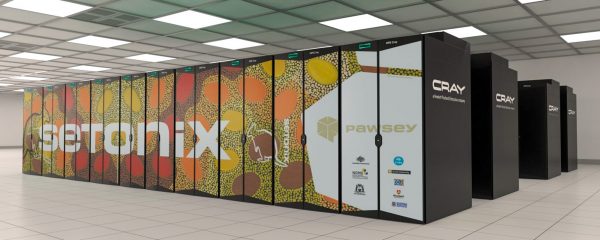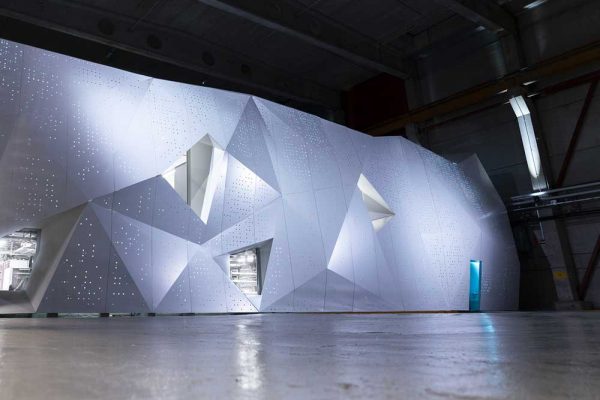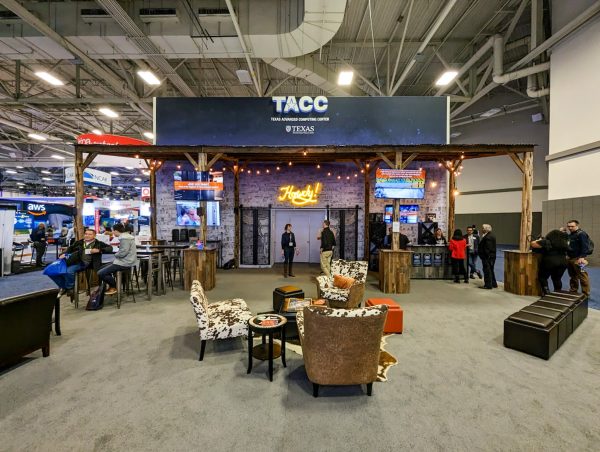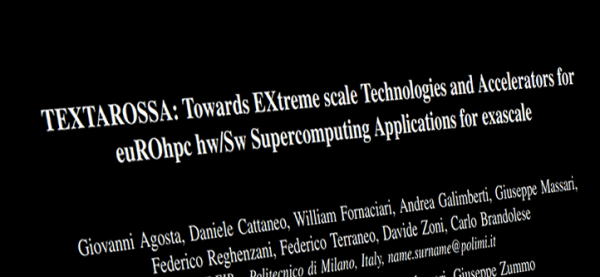Each November, HPCwire’s readers and editors recognize dozens of individuals and organizations across more than 20 very serious award categories, celebrating technology innovations and HPC-driven research that will transform both the industry and the world.
But throughout the year, while covering these developments, there are lots of nooks and crannies in the HPC community that go unsung: in-jokes, art, madcap marketing and oddball research that make the rounds in our meetings but rarely get their own spotlight. So this year – around the time when news tends to be slow! – we decided to shake things up a bit by issuing a few somewhat less serious (but still very sincere) HPCwire Superlative Awards to celebrate the little details that we enjoyed over the past year or so.
Favorite Supercomputer Name
Frontier, Crusher and Borg
The world’s most powerful publicly-ranked supercomputer, Frontier, has – at first glance – a fairly generic name. We covered Frontier for years before learning that the system was flanked by a one-cabinet test and development system called “Borg” and another 1.5-cabinet test system named “Crusher.” These names, respectively, reference the most iconic villains and the chief medical officer from Star Trek: The Next Generation – references that then wink at Frontier itself, calling to mind the show’s iconic opening narration: “Space… the final frontier.” This clever recontextualization and essentially nerdy set of references earns the Oak Ridge National Lab-based trio of systems our superlative award for Favorite Supercomputer Name. Also noteworthy: an Oak Ridge representative confirmed that Crusher is indeed specifically named after Beverly Crusher, rather than her much-maligned son, Wesley.
Also of note: “Setonix,” the scientific name for the world’s cutest animal, also graces the new flagship supercomputer at the Pawsey Supercomputing Centre in Perth; it’s a name we’ve always loved with a mascot to match. This past year also saw the launch of a few systems with interesting names rooted in mythology and folklore: EuroHPC’s MeluXina supercomputer in Luxembourg, named for the mermaid Melusina; Petrobras’ Pégaso system, named for the winged horse Pegasus (Petrobras has a penchant for these names, with other systems named Fênix and Dragão); and the Zaratan cluster at the University of Maryland, named for a gigantic, mythical sea turtle (Zaratan succeeds Deepthought2 at UMD – another essential nerdy reference). We also enjoyed the beauty and simplicity of LUMI’s name (“snow” in Finnish) and the charming story behind this year’s Green500 topper, Henri, which was named after the newborn son of one of the system’s managers.
Favorite Cabinet Art
Setonix
Since the launch of its Magnus system eight years ago, the Pawsey Supercomputing Centre has adorned its supercomputer cabinets with designs by indigenous artists. It’s a beautiful tradition, and a meaningful one: much of Pawsey’s work revolves around radio astronomy data collected by radio telescopes sited on indigenous lands with famously dark skies. This relationship is set to greatly expand in coming years via the installation of the Australian portion of the Square Kilometre Array (set to become the largest radio telescope array in the world), which will be built on Wajarri land following an indigenous land use agreement that was signed this past year.
The art for Setonix, in Pawsey’s words, is a “representation of Aboriginal astronomy,” a practice that dates back thousands of years and which was crucial to navigation across the vast continent. The warm, starry pattern on the cabinets was created by Wajarri Yamatji artist Margaret Whitehurt and is specifically meant to evoke the stars over the Wajarri country where the SKA will be built. We love the art on Setonix: rooted in important (and often overlooked) scientific history, but distinct from the European and American design motifs most commonly associated with technology. For all these reasons, Setonix earns our superlative award for Favorite Cabinet Art.
Also of note: This superlative could have gone jointly to “Australia”; another new system, Taingiwilta, launched this year to support the Australian Department of Defence – and, like Setonix and others before it, Taingiwilta (named after the word for “powerful” in the language of the Kaurna people) is accompanied by beautiful indigenous art (in this case, designed by three generations of one Kaurna family). However, we’re not sure whether this art actually adorns the supercomputer cabinets. Gadi, also launched in the last couple of years, is part of NCI Australia and features a beautiful concentric blue design by Ngunnawal artist Lynnice Church.

Outside of Australia, we enjoyed the maximalist science-themed artwork on both the Polaris system at Argonne National Laboratory and on the endcaps of the Snellius system in the Netherlands. In Sweden, KTH’s new Dardel system serves as a lovely new canvas for existing artwork by Nils Dardel, depicting a story by author Thora Dardel (his wife) as well as his portrait of her.
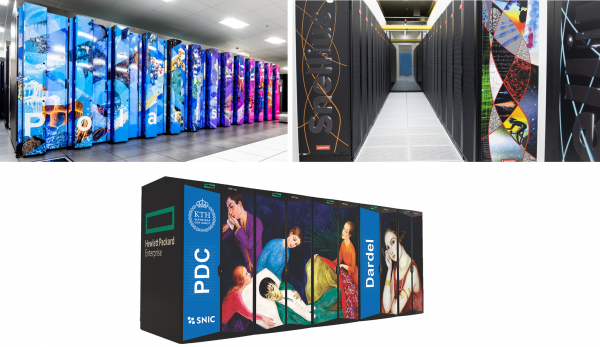
We also wanted to give a nod to the EuroHPC/CINECA Leonardo system, which strikingly spells out the system name one letter at a time on the endcaps of cabinet rows – certainly a bold way to communicate the sheer scale of such a powerful system. And, finally, we wanted to mention the mesmerizing design of Atos’ new XH3000 cabinets, which we got the chance to see in person at SC22.

Favorite Datacenter Design
LUMI
We’ve given plenty of awards to the EuroHPC/CSC LUMI supercomputer and its datacenter over the past couple of years in recognition of the remarkable power and sustainability of the new system and the facility that houses it. Setting all that aside, though, it just looks rad: designed by Synopsis Architects, the ultramodern datacenter is housed in a former paper mill and utilizes what Synopsis calls a “snow crystal envelope structure,” echoing the system’s name (which, as mentioned before, means “snow”). For building one of the world’s most sustainable datacenters, we’ve given LUMI other awards – for doing it in style, we’re giving it our superlative award for Favorite Datacenter Design.
Also of note: On the topic of sustainable datacenters, two others caught our eye this year: first, QScale, with a modern datacenter sited adjacent to (and coordinating with) scenic hydropower and large, glowing greenhouses; second, Lancium, operating at the other end of the spectrum with low-tech datacenters it has affectionately described as “chicken sheds.” And, of course, we were wowed by the sheer scale (and relative quiet) of Frontier’s datacenter during our most recent visit to Oak Ridge. In past years, this award likely would have gone by default to the perennially stunning datacenter that houses MareNostrum 4 (a converted chapel!), but we limited eligibility based on recency; we look forward to whatever tricks the Barcelona Supercomputing Center has up its sleeve for MareNostrum 5.
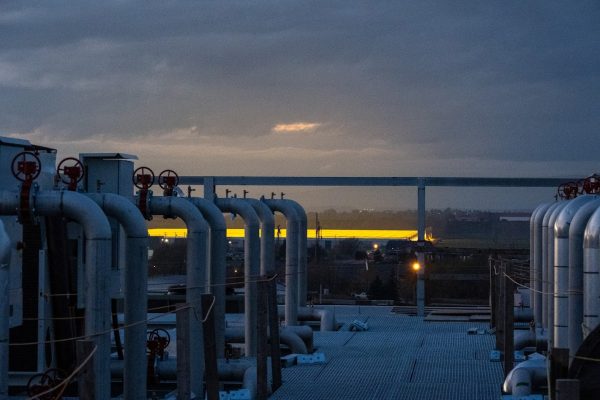
Favorite Booth Presence
Texas Advanced Computing Center (TACC)
It was TACC’s time to shine this year at SC22 in Dallas, just a few hours away from the center’s headquarters in Austin. And TACC didn’t disappoint, playing up its Texan roots with a sprawling, ranch-style booth, complete with cow-print armchairs and sliding barn doors. TACC’s booth also sported some of the best HPC swag of the year: well-designed glass mugs and t-shirts, along with a classic “My other computer is super” sticker (infinitely more likely to be actually used and enjoyed than a simple brand sticker!). TACC has a lot to look forward to over the next few years as its Leadership-Class Computing Facility (LCCF) moves closer and closer to reality; its presence at SC22 communicated that leadership position and had fun, to boot. Call it a home-field advantage if you must, but TACC earned our superlative award for Favorite Booth Presence.
Also of note: At SC22, we enjoyed the HPE booth, which featured an original Cray-1 supercomputer on display for photos, and the IBM booth, which featured a life-size model of the company’s AI-powered autonomous ship, the Mayflower (which completed its transatlantic voyage last summer). We also heard that one particularly cool exhibitor at SC22 gave away a Harley-Davidson motorcycle.

Favorite Offbeat Workload
Molecular dynamics for odor neutralization
We cover a lot of research that focuses on diminishing the negative impacts of industry – but one we hadn’t seen before was HPC-driven work aimed at helping to neutralize the odors produced by industrial sites like factories and landfills. The research in question was conducted by researchers from the University of New Orleans and the Jefferson Parish Department of Environmental Affairs and leveraged the Comet supercomputer at the San Diego Supercomputer Center to model how different molecular components could be arranged to most effectively counter the smell of toluene. This research is off the beaten path for us, and we found it fascinating. Here’s hoping that HPC can help make everyone’s next trip through farm country a little less smelly. The authors of the paper – Edwin Gomez, Richard Mayer, Laura Eschette Becker and Sylvester Tumusiime – earn our superlative award for Favorite Offbeat Workload.
Also of note: Exxact published a case study discussing how its new GPU workstations were used to study ant epigenetics, aiming to better understand how genetically identical ants still have distinct castes and sets of behavior.
Favorite Zany Acronym
TEXTAROSSA
The TEXTAROSSA project, which comprises 11 partners across five countries, aims to increase hardware efficiencies through co-design in advance of forthcoming European exascale systems. It’s an interesting, meaningful project – hence crossing our radar – but we certainly scratched our heads when we saw the breakdown of the name: Towards EXtreme scale Technologies and Accelerators for euROhpc hw/Sw Supercomputing Applications for exascale. For those impressive backronym gymnastics, the TEXTAROSSA project takes home the superlative award for our Favorite Zany Acronym.
Also of note: From this past year’s slate of acronyms, we were also fond of the Department of Energy’s COOLERCHIPS (Cooling Operations Optimized for Leaps in Energy, Reliable and Carbon Hyperefficiency for Information Processing Systems) program.
Until next time!
We hope to return with more superlative awards next year – new systems, new booths, new acronyms, new categories! Until then, if we missed something – or if you want to make sure something superlative crosses our radar – feel free to reach out via email or Twitter.


